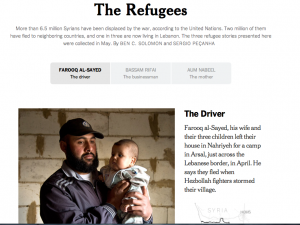This multimedia piece by the New York Times is a great example of the journalistic pieces we are currently producing. Many of the shots in this piece are done in a clever way that helps convey the idea of the title, since most of the subjects being interviewed are discussing the culture of women’s bodies in Venezuala while they are surrounded by the altered mannequins, are adjusting the shapes of the mannequins, or are getting work done to their own body.
We have the two camera interview set up at the beginning that the producers cut to throughout the piece, as well as single camera and action interviews along the way, so it’s a great piece for reference when contemplating using a mix of interview styles. The surgery shots are grotesquely powerful, and the constant shots of mannequin bodies piled on one another or stacked in a shed remind us just how superficial and manufactured our idea of beauty can be.
